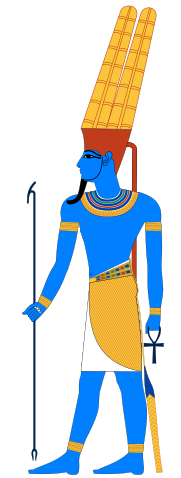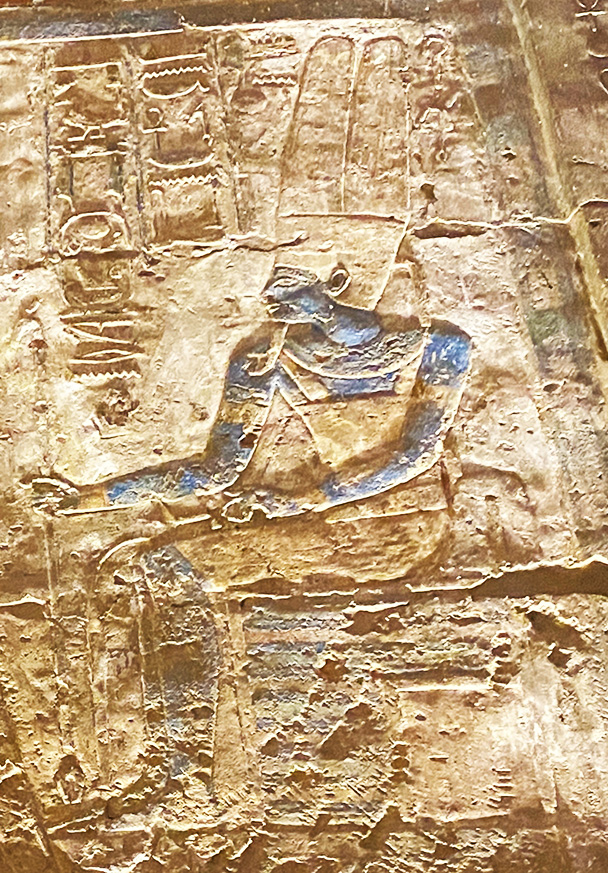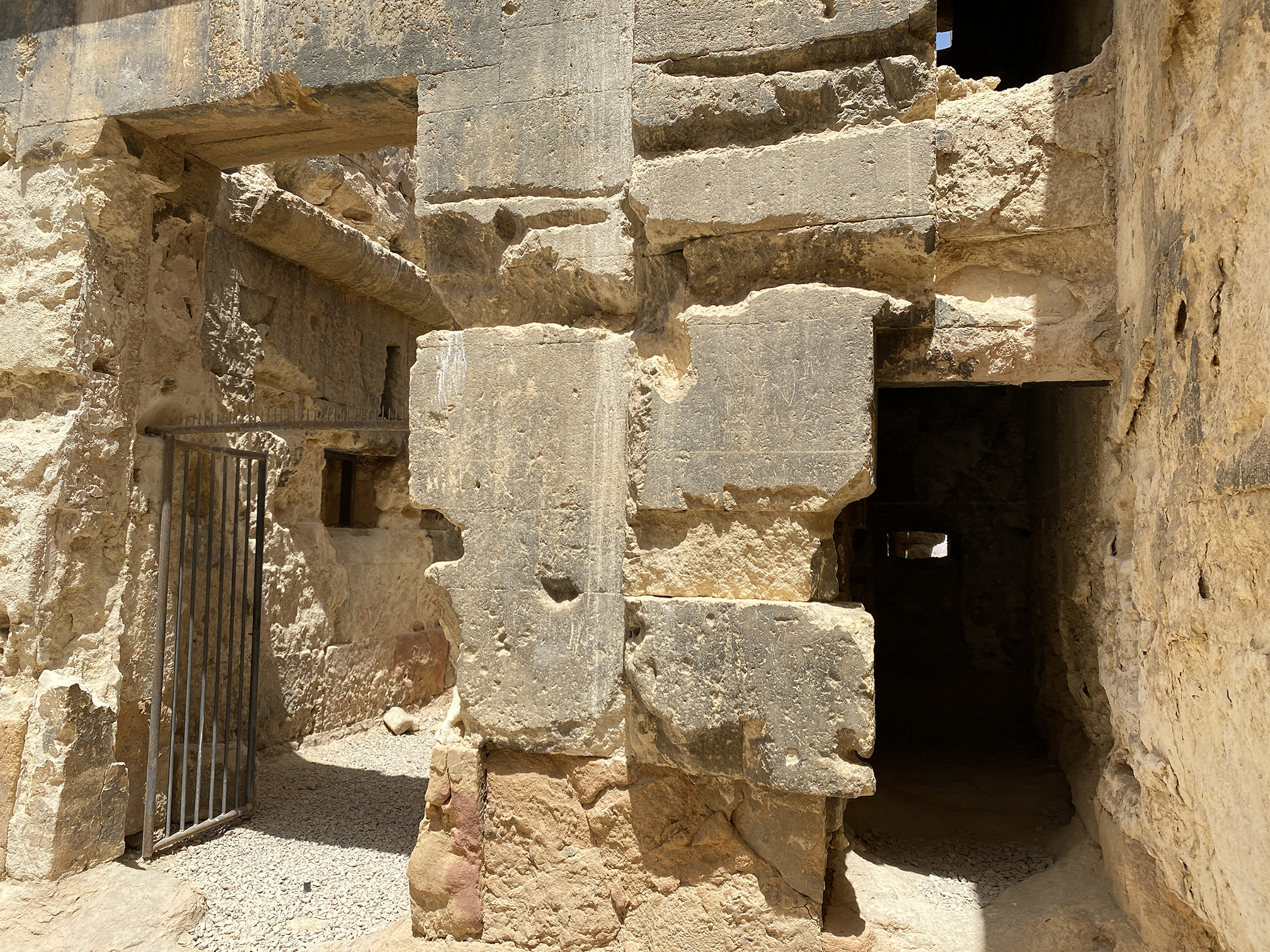Difference between revisions of "Amun-Ra"
Occultwiki (talk | contribs) |
Occultwiki (talk | contribs) |
||
| Line 28: | Line 28: | ||
Subsequently, when Egypt conquered Kush, they identified the chief deity of the Kushites as Amun. This Kush deity was depicted as ram-headed, more specifically a woolly ram with curved horns. Amun thus became associated with the ram arising from the aged appearance of the Kush ram deity, and depictions related to Amun sometimes had small ram's horns, known as the Horns of Ammon. A solar deity in the form of a ram can be traced to the pre-literate Kerma culture in Nubia, contemporary to the Old Kingdom of Egypt. Since rams were considered a symbol of virility, Amun also became thought of as a fertility deity, and so started to absorb the identity of Min, becoming Amun-Min. This association with virility led to Amun-Min gaining the epithet Kamutef, meaning "Bull of his mother," in which form he was found depicted on the walls of Karnak, with an erect penis, carrying a scourge, as Min was. | Subsequently, when Egypt conquered Kush, they identified the chief deity of the Kushites as Amun. This Kush deity was depicted as ram-headed, more specifically a woolly ram with curved horns. Amun thus became associated with the ram arising from the aged appearance of the Kush ram deity, and depictions related to Amun sometimes had small ram's horns, known as the Horns of Ammon. A solar deity in the form of a ram can be traced to the pre-literate Kerma culture in Nubia, contemporary to the Old Kingdom of Egypt. Since rams were considered a symbol of virility, Amun also became thought of as a fertility deity, and so started to absorb the identity of Min, becoming Amun-Min. This association with virility led to Amun-Min gaining the epithet Kamutef, meaning "Bull of his mother," in which form he was found depicted on the walls of Karnak, with an erect penis, carrying a scourge, as Min was. | ||
As the cult of Amun grew in importance, Amun became identified with the chief deity who was worshipped in other areas during that period, namely the [[sun]] god [[Ra]]. This identification led to another merger of identities, with Amun becoming Amun-Ra. In the ''Hymn to Amun-Ra'' he is described as: "Lord of truth, father of the gods, maker of men, creator of all animals, Lord of things that are, creator of the staff of life." | As the [[cult]] of Amun grew in importance, Amun became identified with the chief deity who was worshipped in other areas during that period, namely the [[sun]] god [[Ra]]. This identification led to another merger of identities, with Amun becoming Amun-Ra. In the ''Hymn to Amun-Ra'' he is described as: "Lord of truth, father of the gods, maker of men, creator of all animals, Lord of things that are, creator of the staff of life." | ||
==Decline== | ==Decline== | ||
| Line 36: | Line 36: | ||
==Worship outside Egypt== | ==Worship outside Egypt== | ||
In areas outside Egypt where the Egyptians had previously brought the cult of Amun his worship continued into classical antiquity, even after the god was no longer revered inside Egypt. | In areas outside Egypt where the Egyptians had previously brought the [[cult]] of Amun his worship continued into classical antiquity, even after the god was no longer revered inside Egypt. | ||
===Nubia and Sudan=== | ===Nubia and Sudan=== | ||
Latest revision as of 16:52, 15 November 2024
Amun-Ra (Ancient Egyptian: jmn) was a major ancient Egyptian deity who appears as a member of the Hermopolitan Ogdoad. Amun was attested from the Old Kingdom together with his wife Amunet. With the 11th Dynasty (c. 21st century BC), Amun rose to the position of patron deity of Thebes by replacing Montu.
After the rebellion of Thebes against the Hyksos and with the rule of Ahmose I (16th century BC), Amun acquired national importance, expressed in his fusion with the Sun god, Ra, as Amun-Ra (alternatively spelled Amon-Ra or Amun-Re).
Amun-Ra retained chief importance in the Egyptian pantheon throughout the New Kingdom. Amun-Ra in this period (16th to 11th centuries BC) held the position of transcendental, self-created creator deity "par excellence;" he was the champion of the poor or troubled and central to personal piety. With Osiris, Amun-Ra is the most widely recorded of the Egyptian gods.
As the chief deity of the Egyptian Empire, Amun-Ra also came to be worshipped outside Egypt, according to the testimony of ancient Greek historiographers in Libya and Nubia. As Zeus Ammon and Jupiter Ammon, he came to be identified with Zeus in Greece and Jupiter in Rome.
Beliefs
The god of wind, Amun, came to be identified with the solar god Ra and the god of fertility and creation Min, so that Amun-Ra had the main characteristic of a solar god, creator god, and fertility god. He also adopted the aspect of the ram from the Nubian solar god, besides numerous other titles and aspects.
As Amun-Re, he was petitioned for mercy by those who believed suffering had come about as a result of their own or others' wrongdoing.
In the Leiden hymns, Amun, Ptah, and Ra are regarded as a trinity who are distinct gods but with unity in plurality. "The three gods are one yet the Egyptian elsewhere insists on the separate identity of each of the three."
Old Kingdom
Amun and Amaunet are mentioned in the Old Kingdom Pyramid Texts. The name Amun (written imn) meant something like "the hidden one" or "invisible."
Amun rose to the position of tutelary deity of Thebes after the end of the First Intermediate Period, under the 11th Dynasty. As the patron of Thebes, his spouse was Mut. In Thebes, Amun as father, Mut as mother and the Moon god Khonsu as their son formed the divine family or the "Theban Triad."
New Kingdom assimilation with Ra
When the army of the founder of the Eighteenth Dynasty expelled the Hyksos rulers from Egypt, the victor's city of origin, Thebes, became the most important city in Egypt, the capital of a new dynasty. The local patron deity of Thebes, Amun, therefore became nationally important. The pharaohs of that new dynasty attributed all of their successes to Amun, and they lavished much of their wealth and captured spoil on the construction of temples dedicated to Amun.
The victory against the "foreign rulers" achieved by pharaohs who worshipped Amun caused him to be seen as a champion of the less fortunate, upholding the rights of justice for the poor. By aiding those who traveled in his name, he became the Protector of the road. Since he upheld Ma'at (truth, justice, and goodness), those who prayed to Amun were required first to demonstrate that they were worthy, by confessing their sins.
Subsequently, when Egypt conquered Kush, they identified the chief deity of the Kushites as Amun. This Kush deity was depicted as ram-headed, more specifically a woolly ram with curved horns. Amun thus became associated with the ram arising from the aged appearance of the Kush ram deity, and depictions related to Amun sometimes had small ram's horns, known as the Horns of Ammon. A solar deity in the form of a ram can be traced to the pre-literate Kerma culture in Nubia, contemporary to the Old Kingdom of Egypt. Since rams were considered a symbol of virility, Amun also became thought of as a fertility deity, and so started to absorb the identity of Min, becoming Amun-Min. This association with virility led to Amun-Min gaining the epithet Kamutef, meaning "Bull of his mother," in which form he was found depicted on the walls of Karnak, with an erect penis, carrying a scourge, as Min was.
As the cult of Amun grew in importance, Amun became identified with the chief deity who was worshipped in other areas during that period, namely the sun god Ra. This identification led to another merger of identities, with Amun becoming Amun-Ra. In the Hymn to Amun-Ra he is described as: "Lord of truth, father of the gods, maker of men, creator of all animals, Lord of things that are, creator of the staff of life."
Decline
In the 10th century BC, the overwhelming dominance of Amun over all of Egypt gradually began to decline. In Thebes, however, his worship continued unabated, especially under the Nubian Twenty-fifth Dynasty of Egypt, as Amun was by now seen as a national god in Nubia. The Temple of Amun, Jebel Barkal, founded during the New Kingdom, came to be the center of the religious ideology of the Kingdom of Kush. The Victory Stele of Piye at Gebel Barkal (8th century BC) now distinguishes between an "Amun of Napata" and an "Amun of Thebes."
Tantamani (died 653 BC), the last pharaoh of the Nubian dynasty, still bore a theophoric name referring to Amun in the Nubian form Amani.
Worship outside Egypt
In areas outside Egypt where the Egyptians had previously brought the cult of Amun his worship continued into classical antiquity, even after the god was no longer revered inside Egypt.
Nubia and Sudan
In Nubia, where his name was pronounced Amane or Amani, he remained a national deity, with his priests, at Meroe and Nobatia, regulating the whole government of the country via an oracle, choosing the ruler, and directing military expeditions. According to Diodorus Siculus, these religious leaders were even able to compel kings to commit suicide, although this tradition stopped when Arkamane, in the 3rd century BC, slew them.
The last known temple of Amon was located at Dangeil in Sudan and is believed to have been utilized in the 1st century AD before being destroyed by fire.
Judaism
Amun is mentioned in the Hebrew Bible as אמון מנא Amon of No in Jeremiah 46:25 (also translated the "Horde of No" or the "Horde of Alexandria"), and Thebes possibly is called נא אמון No-Amon in Nahum 3:8. These texts were presumably written in the 7th century BC.
The Lord of hosts, the God of Israel, said: "Behold, I am bringing punishment upon Amon of Thebes, and Pharaoh and Egypt and her gods and her kings, upon Pharaoh and those who trust in him."
- — Jeremiah 46:25 (KJV)
Greece
Amun, worshipped by the Greeks as Ammon, had a temple and a statue at Thebes and another at Sparta, the inhabitants of which consulted the Oracle of Amun in Libya from early times more than the other Greeks. At Aphytis, Chalcidice, Amun was worshipped, from the time of Lysander (d. 395 BC), as zealously as in Ammonium. Pindar the poet honored the god with a hymn. At Megalopolis, the god was represented with the head of a ram (Paus. viii.32 § 1), and the Greeks of Cyrenaica dedicated at Delphi a chariot with a statue of Ammon.
Temple in Siwa
- Main article: Oracle of Amun
In Siwa Oasis, located Western Egypt, there remained a solitary oracle of Amun near the Libyan Desert. The worship of Ammon was introduced into Greece at an early period, probably through the medium of the Greek colony in Cyrene, which must have formed a connection with the great Oracle of Ammon in the Oasis soon after its establishment.
When Alexander the Great occupied Egypt in late 332 BC, he was regarded as a liberator, thus conquering Egypt without a fight. He was pronounced son of Amun by the oracle at Siwa. Amun was identified as a form of Zeus and Alexander often referred to Zeus-Ammon as his true father, and after his death, currency depicted him adorned with the Horns of Ammon as a symbol of his divinity. The tradition of depicting Alexander the Great with the horns of Amun continued for centuries, with Alexander being referred to in the Quran as Dhu al-Qarnay ("The Two-Horned One"), a reference to his depiction on Middle Eastern coins and statuary as having horns of Ammon.
Legacy
Several words derive from Amun via the Greek form, Ammon, such as ammonia and ammonite. The Romans called the ammonium chloride they collected from deposits near the Temple of Jupiter-Amun in ancient Libya sal ammoniacus (salt of Amun) because of proximity to the nearby temple.
Ammonia, as well as being the chemical, is a genus name in the foraminifera. Both these foraminiferans (shelled Protozoa) and ammonites (extinct shelled cephalopods) bear spiral shells resembling a ram's, and Ammon's, horns. The regions of the hippocampus in the brain are called the cornu ammonis – literally "Amun's Horns," due to the horned appearance of the dark and light bands of cellular layers.
In Paradise Lost, Milton identifies Ammon with the Biblical Ham (Cham) and states that the gentiles called him the Libyan Jove.


